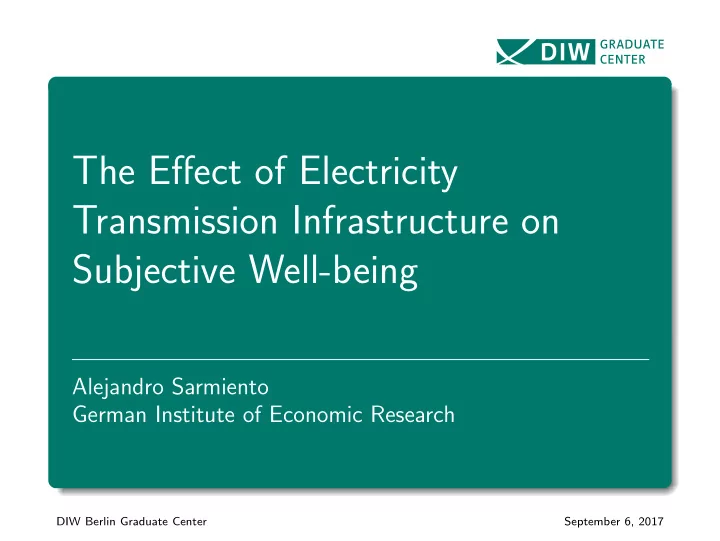

The Effect of Electricity Transmission Infrastructure on Subjective Well-being Alejandro Sarmiento German Institute of Economic Research DIW Berlin Graduate Center September 6, 2017
Introduction The Life Satisfaction Approach Data Preliminary Results Motivation Electricity transmission infrastructure is likely to impose negative effects on households. In this paper, we analyze this claim through a new and promising technique, the life satisfaction approach : The life satisfaction approach is an additional technique that complements traditional methods used to assess the external effects of power towers, like hedonic regressions and stated preference questionnaires. The idea is to shed additional light on the well-being consequences of proximity to power towers. Alejandro Sarmiento Transmission Infrastructure and Subjective Well-being
Introduction The Life Satisfaction Approach Data Preliminary Results Policy Relevance Every cost benefit analysis of infrastructure projects requires accurate cost assessments. Siting difficult, public opposition, and general cost valuation of transmission lines call for a robust valuation of the external costs imposed on households in proximity to power towers. Alejandro Sarmiento Transmission Infrastructure and Subjective Well-being
Introduction The Life Satisfaction Approach Data Preliminary Results Research Objective Quantify the effects that proximity to transmission infrastructure has on personal well-being. Alejandro Sarmiento Transmission Infrastructure and Subjective Well-being
Introduction The Life Satisfaction Approach Data Preliminary Results Literature and Contribution Related literature: Hedonic pricing: (Franois, 2002), (Sims and Dent, 2005), (Hamilton and Schwann, 1995). Stated preferences: literature review in (Jackson and Pitts, 2010). Life satisfaction: Krekel and Zerrahn (2017), (Van Praag and Baarsma, 2005), (Welsch, 2002). This paper contributes to current literature as it is the first using the life satisfaction approach to value the external costs of power towers. Alejandro Sarmiento Transmission Infrastructure and Subjective Well-being
Introduction The Life Satisfaction Approach Data Preliminary Results Empirical Research Design: Treatment Effect Estimation Treatment effect estimation to quantify the effect that proximity of power towers to households has on self-reported well-being. Treatment group: Individuals with power towers in a pre-specified treatment radius, e.g. 100 m. or 1500 m. from the household. Control group: Individuals with no power tower in proximity to their household and comparable to the treatment in terms of other relevant covariates. Treatment effect: Statistical difference between treatment and control groups in terms of well-being due to proximity effects. Here: Pooled ordinary least squared regression as a preliminary step in the analysis. Alejandro Sarmiento Transmission Infrastructure and Subjective Well-being
Introduction The Life Satisfaction Approach Data Preliminary Results The Life Satisfaction Approach SWB it = f ( tower it + MIC it + MAC it ) Advantages: Avoids framing and several other biases typical of stated preference methods. Does not rely on assumptions such as perfect equilibrium in market goods and choice rationality of agents, necessary for revealed preference assessments. Does not require cognitive abstraction of the mechanisms affecting the individual. Alejandro Sarmiento Transmission Infrastructure and Subjective Well-being
Introduction The Life Satisfaction Approach Data Preliminary Results Data German Socioeconomic Panel Study: German panel data study comprising a large set of economic and socio-demographic variables on a representative sample of German households. Access to geo-coded households. New self-constructed data set on power towers: Data extracted from open source ”OpenStreetMap”. Thoroughly data review through satellite images. The final set has 35,498 households of which 2,067 have at least one high voltage ( ≥ 220 kV) power tower in an 800 meters radius. Alejandro Sarmiento Transmission Infrastructure and Subjective Well-being
Introduction The Life Satisfaction Approach Data Preliminary Results Power Towers in Germany 220 kV & 380 kV 110 kV Alejandro Sarmiento Transmission Infrastructure and Subjective Well-being
Introduction The Life Satisfaction Approach Data Preliminary Results Preliminary Regression Results Dependent variable: satisfaction with life Treatment radius in meters 100 300 400 500 750 Treatment − 0 . 4523 ∗∗∗ − 0 . 1952 ∗∗∗ − 0 . 1713 ∗∗∗ − 0 . 1511 ∗∗∗ − 0 . 1871 ∗∗∗ (0.1784) (0.0467) (0.0402) (0.0297) (0.0253) Income 0 . 0001 ∗∗∗ 0 . 0001 ∗∗∗ 0 . 0001 ∗∗∗ 0 . 0001 ∗∗∗ 0 . 0001 ∗∗∗ (0.0000) (0.0000) (0.0000) (0.0000) (0.0000) − 1 . 0179 ∗∗∗ − 1 . 0118 ∗∗∗ − 1 . 0191 ∗∗∗ − 1 . 0186 ∗∗∗ − 1 . 0203 ∗∗∗ Unemployment (0.0387) (0.0386) (0.0385) (0.0384) (0.0379) Bad health − 0 . 2546 ∗∗∗ − 0 . 2485 ∗∗∗ − 0 . 2468 ∗∗∗ − 0 . 2467 ∗∗∗ − 0 . 2462 ∗∗∗ (0.0138) (0.0140) (0.0140) (0.0141) (0.0142) N 165,908 165,908 165,908 165,908 165,908 Size of the treatment group 60 499 733 1028 2119 Size of the control group 33,621 33,493 33,456 33,418 33,250 R 2 0.0792 0.0790 0.0792 0.0791 0.0797 Heteroskedasticity-robust standard errors in parentheses, clustered at the individual level. * , ** , *** indicate significance at 10%, 5%, and 1% levels, respectively. Estimation Equation : SWB it = α + β tower it + MIC ′ it γ 1 + MAC ′ it γ 2 + � t δ t year t + ǫ it Alejandro Sarmiento Transmission Infrastructure and Subjective Well-being
Introduction The Life Satisfaction Approach Data Preliminary Results Conclusion Strong, statistically, and economically significant negative relation between treatment status and subjective well-being. The relationship appears to decrease with treatment intensity (distance to the power tower). Alejandro Sarmiento Transmission Infrastructure and Subjective Well-being
Introduction The Life Satisfaction Approach Data Preliminary Results Further Steps Ultimate goal of the analysis: identify causal effect of power towers on well-being. Problems to address: self-selection and adaptability: Exploit temporal variation on construction dates of high voltage power towers. Exploit other forms of exogenous temporal variation. Identify the effect of construction and assess temporal adaptability. Further, determine the willingness to pay from the substitutability relation between income and externality exposure. Alejandro Sarmiento Transmission Infrastructure and Subjective Well-being
Thank you. DIW Berlin – Deutsches Institut f¨ ur Wirtschaftsforschung e.V. Mohrenstraße 58, 10117 Berlin www.diw.de
Recommend
More recommend